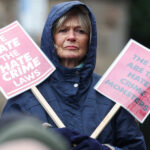Published April 11, 2007
Last December’s visit by Pope Benedict XVI to Ecumenical Patriarch Bartholomew of Constantinople revived speculation that the millennium-long division between Rome and the Christian East might soon end.
That was certainly the dream of Benedict’s predecessor, the Servant of God John Paul II, who really did seem to believe that Rome and Constantinople could achieve ecclesial reconciliation by the end of the twentieth century, so that a millennium of division — the formal split having taken place in 1054 — would be succeeded by a new millennium of unity, in a return to the relations that prevailed in the first centuries of Christian history.
It was a noble vision, but it may not have accurately measured the depth of the chasm between Catholicism and some parts of the worlds-within-worlds of Orthodoxy. Recent comments on Benedict’s December pilgrimage by the Orthodox monks of Mount Athos suggest that the division is deep and wide indeed.
Mount Athos, a craggy peninsula in northern Greece, is home to 20 self-governing Orthodox monasteries. In fact, Mount Athos is virtually a country unto itself; its formal designation in Greece is the “Autonomous Monastic State of the Holy Mountain.” No women or female animals are allowed on Mount Athos; visitors are strictly limited; only male members of the Orthodox Church may become monks.
And, while Mount Athos comes under the ecclesiastical jurisdiction of the Ecumenical Patriarchate of Constantinople, the Athonite monks, who regard their monasticism as what they term “the non-negotiable guardian of the Holy Tradition,” were very unhappy with Ecumenical Patriarch Bartholomew and the way he treated his Roman guest in December.
Why? Because, the monks complained, “the Pope was received as though he were the canonical bishop of Rome.” There were other complaints, but that was the first listed in a statement released last December 30 by the Assembly of Representatives and Superiors of the twenty monasteries: Why was Bartholomew treating Benedict as though the latter were, in fact, the bishop of Rome?
Well, if we can’t agree on that, we do have, as Jim Lovell told Mission Control, a problem.
To be sure, Athonite monasticism, “the non-negotiable guardian of the Holy Tradition,” is a particularly stringent form of Orthodoxy. And if the monks of Mount Athos have their dubieties about the ecumenical openness of Patriarch Bartholomew, it is, perhaps, not surprising that they imagine Benedict XVI as a usurper and a teacher of heresies.
Yet this Athonite intransigence reflects a hard truth about Catholic-Orthodox relations after a millennium of division: namely, that, for many Orthodox Christians, the statement “I am not in communion with the Bishop of Rome” has become an integral part of the statement, “I am an Orthodox Christian.”
The obverse is not true. I very much doubt that there are more than a handful of Catholics around the world whose confession of Catholic faith includes, as a key component, “I am not in communion with the Patriarch of Constantinople.”
The truth of the matter is that, outside historically Orthodox countries and certain ethnic communities, the thought of how one stands vis-à-vis the Patriarch of Constantinople simply doesn’t enter Catholic heads. Perhaps that’s a problem, but it’s nowhere near as great an obstacle to ecumenical progress as the conviction in some Orthodox quarters that non-communion with Rome is a defining characteristic of what it means to be “Orthodox.”
1054, it now seems clear, was not a date-in-a-vacuum. Rather, the mutual excommunications of 1054 were the cash-out, so to speak, of a drifting-apart that had been going on for centuries, driven by language and politics, to be sure, but also by different theological sensibilities. Are those two sensibilities necessarily Church-dividing? The Catholic answer is, “No.” But that is emphatically not the answer of Mount Athos, and of those Orthodox for whom the Athonite monks are essentially right, if a bit over-the-top.
All of which suggests that John Paul II’s dream of a Church breathing once again with both of its lungs is unlikely of fulfillment anytime soon. Unless, that is, Islamist pressures compel a reexamination within Orthodoxy of what a life-line to Rome might mean.
George Weigel is Distinguished Senior Fellow of the Ethics and Public Policy Center in Washington, D.C. and holds EPPC’s William E. Simon Chair in Catholic Studies.








